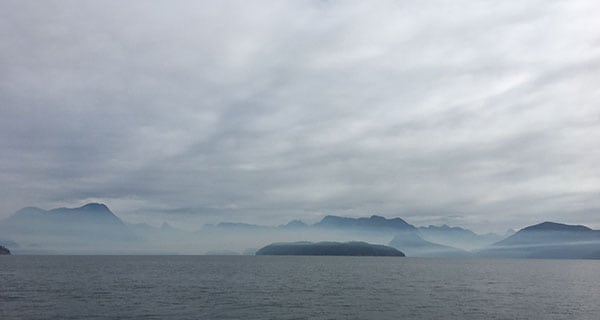
East Redonda Island covered in smoke on Sept. 2, 2018. We wanted a dip and so we cast off with swim suits and a plan to eat lunch in Refuge Cove. The plan was foiled by a human-caused fire
 On the morning of Sept. 2, we decided to take a last trip in our boat into Desolation Sound, the world-class boating destination that lies a mere half hour from our Westview Marina berth in Powell River.
On the morning of Sept. 2, we decided to take a last trip in our boat into Desolation Sound, the world-class boating destination that lies a mere half hour from our Westview Marina berth in Powell River.
All summer we’ve been popping in and out of this destination, taking advantage of blue skies and 30C heat, and a new boat motor that has rejuvenated our enthusiasm for long day trips.
We’ve journeyed up Homfray Channel to swim in Bennett Bay and peek into Toba Inlet. We’ve motored up Waddington Channel to swim in 25C Pendrell Sound in the midst of East Redonda Island. We’ve toured Teakerne Arm on West Redonda Island and had lunch in Refuge Cove.
There have been memorable meals at the Laughing Oyster at the head of Okeover Inlet on the Malaspina Peninsula, and at Nancy’s famous cinnamon buns emporium in Lund.
We got to know Desolation Sound and surrounding areas at least as well as the billionaire crowd aboard the Huntress, the Octopus and the Invictus, all of whom frequent this part of the nautical world in July and August. We see them go by our house at Skelhp, often all lit up at night, as they deliver extraordinarily expensive charter weeks to their deep-pocketed guests.
My knowledge of this part of the world really starts with my father, whose medical pal Bert was John Wayne’s on-call physician when the actor took his converted navy mine sweeper, the Blue Goose, into Desolation Sound for several summers in a row in the mid-to-late 1970s.
In his final years as he battled cancer, Wayne always insisted that a visit to his “favourite spot in the world” be a part of every summer. Bert’s job, as far as I could understand it, was to be ready to administer pain killers and uppers, should the old boy request help. I don’t think he did so very often, at least as far as my dad could recall.
Since we’ve moved into the neighbourhood, we’ve developed an interest in exploring the north end of our coastal range. The area is typically “cold, wet and dark” (our neighbour’s turn of phrase) from November to early April, and our trips in the boat are apt to be exactly that, and foggy, if attempted.
An earlier visitor, Capt. George Vancouver of the British Navy, aptly named the place Desolation Sound in February 1792. He could see no future whatsoever in the place. Had he arrived in May, when the weather turns upside down and becomes hot, dry and bright, he might have demurred.
September, and especially Labour Day weekend, is a bittersweet time in Desolation Sound, perhaps because school has started and the family summer season has definitively ended.
I always try to convince myself that it’s still summer, at least until Sept. 21, but it’s a failing enterprise. The merest turn of weather has my mind racing to November’s impending deluge.
But we still have the urge for one more visit. This year, we decided to cruise back to Pendrell Sound, where locals swear that the water is 22C all winter. It’s something to do with tidal friction and the north and south tides that collide there twice a day. The high granite peaks on either side probably add to the effect as a heat sink.
At any rate, we wanted a dip on Sept. 2 and so we cast off with swim suits and a plan to eat lunch in Refuge Cove.
As we turned at Sarah Point, the front door to Desolation Sound, the plan was doomed. A pall of wood smoke, the curse of this summer and the summer before that, covered the northern backspace of the sound.
It appeared that East Redonda Island was on fire, belching a haze of smoke and ash that you could taste. A quick check of the smartphone revealed that “a human-caused fire” had been kindled in an ecological reserve area on the east flanks of Pendrell Sound – exactly where we planned to have our lunch.
Five firefighters and a helicopter with a water bucket had been dispatched to the area. There was no choice but to reverse course.
Maybe next year!
Troy Media columnist Mike Robinson has been CEO of three Canadian NGOs: the Arctic Institute of North America, the Glenbow Museum and the Bill Reid Gallery.
The views, opinions and positions expressed by columnists and contributors are the author’s alone. They do not inherently or expressly reflect the views, opinions and/or positions of our publication.


